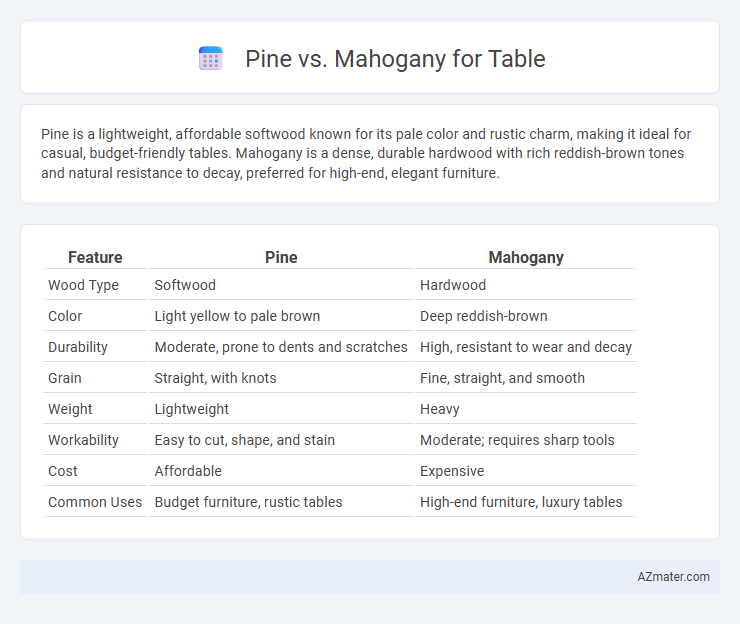Pine is a lightweight, affordable softwood known for its pale color and rustic charm, making it ideal for casual, budget-friendly tables. Mahogany is a dense, durable hardwood with rich reddish-brown tones and natural resistance to decay, preferred for high-end, elegant furniture.
Table of Comparison
| Feature | Pine | Mahogany |
|---|---|---|
| Wood Type | Softwood | Hardwood |
| Color | Light yellow to pale brown | Deep reddish-brown |
| Durability | Moderate, prone to dents and scratches | High, resistant to wear and decay |
| Grain | Straight, with knots | Fine, straight, and smooth |
| Weight | Lightweight | Heavy |
| Workability | Easy to cut, shape, and stain | Moderate; requires sharp tools |
| Cost | Affordable | Expensive |
| Common Uses | Budget furniture, rustic tables | High-end furniture, luxury tables |
Introduction to Pine and Mahogany for Tables
Pine and mahogany are popular wood choices for tables, each offering distinct characteristics. Pine is a softwood with a light color and prominent grain, valued for its affordability and ease of working. Mahogany, a hardwood with a rich reddish-brown hue and dense grain, is prized for its durability, fine finish, and classic elegance in furniture making.
Appearance and Grain Differences
Pine wood offers a lighter, pale yellow to light brown color with visible knots and a straight, uniform grain pattern that adds a rustic charm to tables. Mahogany features a rich, reddish-brown hue with a smooth, fine, and interlocking grain, creating a more elegant and formal appearance for high-end furniture. The distinct grain textures and color variations between pine and mahogany influence the visual warmth and style of tables, making pine ideal for casual or country decor and mahogany perfect for sophisticated, classic interiors.
Durability and Hardness Comparison
Mahogany ranks higher in durability and hardness compared to pine, boasting a Janka hardness rating of approximately 900-1150, making it highly resistant to dents and scratches. Pine, with a Janka hardness around 350-420, is softer and more prone to surface damage but offers flexibility for designs requiring ease of shaping. For table construction, mahogany ensures long-lasting strength and wear resistance, while pine suits lightweight, budget-friendly options with moderate durability.
Weight and Handling Considerations
Pine tables are significantly lighter than mahogany, typically weighing around 20-30 lbs for a standard size, making them easier to move and handle during assembly or relocation. Mahogany, known for its density and durability, can weigh upwards of 50-70 lbs for similar-sized tables, requiring more effort and often additional help when handling. Weight considerations impact not only maneuverability but also the table's stability and durability, with pine offering portability and mahogany providing robust long-term performance.
Cost and Affordability
Pine tables are significantly more affordable than mahogany, making them a popular choice for budget-conscious buyers. Mahogany offers greater durability and a rich, luxurious appearance but comes at a higher price due to its premium quality and slower growth rate. Choosing pine provides cost savings and easier maintenance, while mahogany represents a long-term investment in style and resilience.
Sustainability and Environmental Impact
Pine tables offer a more sustainable choice due to their rapid growth rate and high availability, which reduces deforestation pressure compared to mahogany. Mahogany, often sourced from tropical rainforests, carries a higher environmental impact risk due to slower growth and potential illegal logging practices. Choosing FSC-certified pine or reclaimed mahogany further minimizes ecological footprints and supports responsible forestry management.
Maintenance and Longevity
Pine tables require more frequent maintenance due to their softer wood, which is prone to dents and scratches, often needing regular sealing or refinishing to maintain appearance. Mahogany, a dense hardwood, offers superior durability and longer lifespan with minimal upkeep, resisting wear and moisture better than pine. Choosing mahogany ensures enhanced longevity and less frequent maintenance, while pine demands consistent care to preserve its surface quality.
Suitability for Different Table Styles
Pine is well-suited for rustic, farmhouse, and country-style tables due to its light color, natural knots, and easy workability, making it ideal for casual or vintage aesthetics. Mahogany's dense grain, rich reddish-brown hue, and durability complement formal, traditional, and classic table designs, adding elegance and long-lasting strength. Both woods offer distinct visual and structural qualities that cater to varied stylistic preferences in table construction and interior decor.
Pros and Cons of Pine Tables
Pine tables are favored for their affordability, lightweight nature, and ease of customization due to the softwood's ability to accept stains and paint well. However, pine is more susceptible to dents, scratches, and water damage compared to hardwoods like mahogany, which offers superior durability and natural resistance to wear. The choice depends on budget, desired aesthetic, and long-term durability requirements for table use.
Pros and Cons of Mahogany Tables
Mahogany tables are prized for their rich, deep color and exceptional durability, making them highly resistant to scratches and dents compared to pine. Their dense grain provides a smooth finish that ages gracefully, adding value and elegance to any space. However, mahogany tends to be more expensive and heavier than pine, which can make it less affordable and harder to move or rearrange.

Infographic: Pine vs Mahogany for Table
 azmater.com
azmater.com